by Kraig Kraft

As I mentioned in the previous installment, I went to Mexico in fall, 2006, to collect chiltepíns and other wild varieties of chile pepper for my Ph.D. research on the domestication of C. annuum. Once I had the collection of wild chile peppers in hand, I would be returning to my laboratory at U.C. Davis, where I could start genotyping these specimens, generating a type of genetic fingerprint. Genotyping or generating a DNA fingerprint allows for comparison between different populations or varieties. Under the assumption that the presence of shared patterns in the genotype equates to a shared ancestry, we infer historical relationships by quantifying the amount of shared genetic patterns between different groups.
For my research, I have a couple of questions I’m seeking to answer: 1. What are the relationships between different populations of wild chile peppers? 2. What is the lineage between wild and domesticated C. annuum peppers? The basis of both of these comparisons is dependent on having a great sample that adequately represents all the diversity of the “wild” C. annuum in Mexico. While the chiltepíns that I collected (and consumed!) in Arizona and Sonora (and described in part one) are the most well known and characterized form of C. annuum var. glabriusculum, there are many other varieties that belong to the same sub-species and are distributed throughout Mexico. My collection work had really only just begun.
I mentioned this previously as well, but it bears repeating: plant exploration and collection is a circuitous endeavor. It is not enough to know the region or the locality of your intended specimens; often you still need local help finding the individual plants. I was certain I would find chiltepíns in Sonora and Arizona. I had done the legwork, searched out the contacts, read previous descriptions of the area and I knew that the plants had to be there. After that, I had a rough idea of the potential distribution of wild chile peppers, but did not have any specific locations to target, so I leaned on my Mexican collaborator, Jose (Pepe), who is a professor at the Autonomous University of Aguascalientes, to point me in the right direction. Jose joined me on the road whenever his university schedule allowed. After setting up a base in Guanajuato to come back to and catching up on the data entry of the previous weeks, I met up with Jose and we headed out on our first trip together to Queretaro.
The state of Queretaro is just north of Mexico City (and the state of Mexico) and is not one of the areas that readily comes to mind when thinking about the distribution of wild chiles, but Pepe assured me that there were reports of peppers in the semiarid highlands, just south of the Sierra Gorda. In the capital of the eponymous state, we picked up Pepe’s former student, Neyda, who would serve as our guide and lead us to the small pueblos and communities that harbored chile populations.

We drove back the by the fields planted in corn, nopal cactus and agave that we had passed, found the irrigation canal, and followed it until it ended near a small communal cattle watering hole. We circled the shore of small lake and parked the vehicle. A short walk yielded the elusive peppers. They had small, elongated, piquin-like fruits on short shrubby plants that were still found in association with mesquite trees and hackberries. The biggest surprise was found upon turning on the GPS. We were 2023 meters above sea level, or approximately 6,600 feet, in a rain shadow that is formed by the Sierra Gorda, creating a high altitude desert. This elevation was higher than anything I had seen reported for this species. I did not expect to find wild chile peppers in the central highlands–I expected to find the peppers in lower elevations and near the coast.
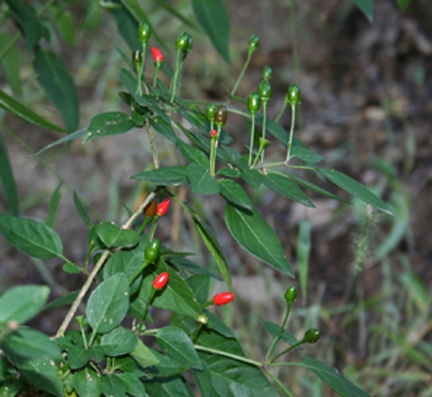
We ended this first day of collecting with arguably one of the best street food experiences I’ve had in Mexico. We stopped in the small town of Bernal, located at the base of a huge monolith that dominates the landscape and is thought to channel spiritual energy. There in the plaza, we sat at a little street food stand–just plastic stools facing a large comal (griddle). We ate the most amazing gorditas made from fresh ground blue corn meal. The raw masa is hand patted into a fat tortilla, filled with a small amount of cheese and red chile sauce, cooked until firm, then cut open and packed with a number of savory combinations, like peppers with nopal (cactus) and cheese, steak, more cheese and chile. Wow.
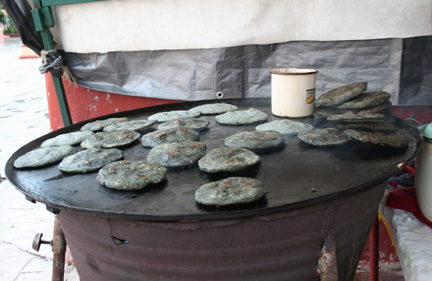
Traveling westward towards the Pacific, the next stop on the chiltepín crusade was Jalisco, where I was lured by stories of non-pungent wild chiles and by the prospect of searching for chiles in Chamela, a tropical dry forest reserve that is located on the impossibly gorgeous costa alegre. Following my leads, I tracked down the source of the non-pungent chile stories, Autlan de Navarro, a medium sized municipality that is situated two hours south of Guadalajara. After meeting my contact in the local university’s botany department, he sent one of his students to guide me to an arroyo on the edge of town. Half an hour’s walk yielded eight plants found in the shade of the steep canyon walls, that bore large, malt-ball sized red fruit. While the characteristics of the plant were similar to previous chiltepín, including the overall shape and color of the fruit, the fruits lacked any sort of pungency. They were a bit bitter and oily but not a trace of heat, which is a real surprise to find in a wild pepper. In wild Capsicum plants, the presence of pungency is a form of defense against seed predators. Basically, it prevents mammals (mainly rodents) from consuming the fruit and destroying the seeds in their digestive system. From the plant’s perspective, the preferred consumer of its fruit are birds (especially from the Mimid family, mockingbirds and thrashers) as birds lack the receptor for capsaicin and do not destroy the seeds in their digestive system. On the contrary, the birds act as primary seed dispersers.
These non-pungent chiltepíns were a mystery. Was this a case of a wild pepper that crossed with a bell? Or is the loss of pungency due to a mutation of a similar ilk to that of bell peppers? Given the Mexican attitude towards chile peppers (Si no pica, no sabe–if it doesn’t “bite” it doesn’t have flavor), it goes without saying that these non-pungent chiles are totally ignored by the locals, leaving them all for the birds. We found another four plants about 20 kilometers away, so this wasn’t an isolated case limited to the arroyo. Hmm. . . Going to have to file this one away for now and see what the DNA tells me later on.
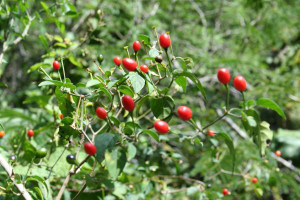
The next day I headed down the road towards the Pacific coast and Chamela, the home to UNAM’s (Mexico’s National University) biological research center for the tropical dry forest (which is coming under attack from developers). I have a friend there, John Williams, who is currently researching the composition of these tropical dry forests. He didn’t notice that right in his survey paths were chiltepíns! Once out in the forest, it was quickly evident that it was getting a bit late in the season for the chiltepínes here, and we had a hard time finding individual plants and the few that we did find had been picked over quite hard by the birds. The plants were restricted to the margins of disturbed environments, the sides of arroyos and the sides of trails in the forest. Of the handful individual plants I did find over three days, only a few had any ripe fruits remaining. The staff at the research center suggested that I go north up the coast to Tomatlan, where “chilpete” (the local name for chiltepín) is harvested and bottled into hot sauces. Upon arriving in the town, I purchased a couple of bottles, which were really “recycled” Corona bottles filled with sauces made from the unripe green fruits, usually pickled with vinegar, or ground to a puree. In this form the sauces were not particularly pungent, but all had a great flavor.
On an impulse, I dialed the phone number listed on the label. I was directed to a home down the street, which doubled as the production plant. The owners were apologetic that I had missed the harvest and the hot sauce making but they invited me to comeback next year to participate in the harvest. I bought a case of hot sauce and left Jalisco, leaving with more questions and hot sauce and than pepper samples.
The final collection location for this trip was Veracruz. By the time Pepe and I had coordinated this visit it was late November, and the peppers at the other locations had been harvested. With our usual approach (and quickly contracting a guide this time), we found “wild” peppers, but they were unlike any other populations that we had looked at previously. There was nothing amiss with the peppers, rather, it was my perception of them. The landscape of Veracruz has been impacted by human activities for so long that there was little “natural” landscape left.
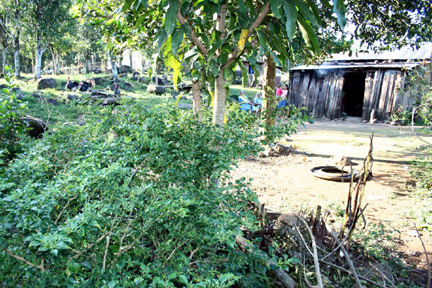
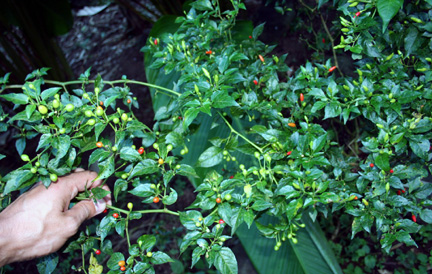
Tlatonile
Tlatonile is a pipian from Jalcomulco, Veracruz. Pipians are spicy dishes from Mexico that utilize ground nuts or seeds. In Mexico, these are most often pumpkin or squash seeds. This recipe is from Susana Rodriguez, who made this for lunch when we were passing through.
2 pounds pork or chicken (thighs and legs)2 chayotes, or use yellow squash, sliced
8 ounces of hulled pumpkin seeds, toasted 1 1/2 ounces of dried ground chile. Susana used a local variety called chile puya 3 Roma tomatoes, halved
1 bunch epazote (a Mexican herb also known as wormweed or Mexican tea)
Salt to taste
Brown the pork or chicken in a stockpot. Add enough water to cover, add the chayote and simmer until cooked. Meanwhile, grind the pumpkin seeds until it forms a thick paste. While the seeds that Susana used were quite high in oil and exuded oil when pressed, I had to add oil to my ground seeds at home. Combine this paste with the dried ground chile, the salt and a small amount of water. Once the meat has cooked, add the halved tomatoes, the pumpkin seed paste and the epazote. Serve in bowls with a bit of rice in the bottom.
Yield: 4 to 6 servings




